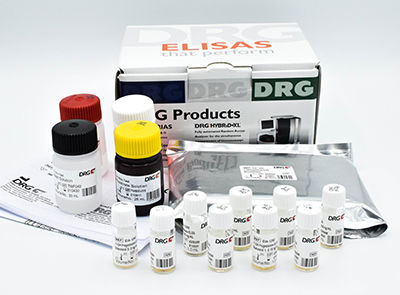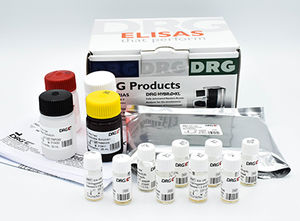
- Laboratory
- Laboratory medicine
- Tuberculosis test kit
- DRG Instruments GmbH
C-reactive protein test kit EIA3954inflammatory processespneumoniatuberculosis
Add to favorites
Compare this product
Characteristics
- Applications
- inflammatory processes, pneumonia, tuberculosis
- Application field
- for hematology
- Tested parameter
- C-reactive protein
- Sample type
- serum, plasma
- Analysis mode
- enzyme immunoassay, molecular
- Result display time
20 min, 45 min
- Sample volume
0.005 ml
(0.00017 US fl oz)
Description
A high sensitivity enzyme immunoassay for the quantitative determination of C-reactive protein (CRP) concentration in serum. C- Reactive protein (CRP) was identified by Tilet and Francis (1930) in the plasma of patients with pneumonia, and was named for its ability to bind and precipitate the C-polysaccharide of pneumococcus.1,2 It is an alpha globulin with a molecular mass of approximately 110,000 to 140,000 daltons, and is composed of five identical subunits, which are noncovalently assembled as a cyclic pentamer.3 CRP is synthesized in the liver and is normally present as a trace constituent of serum or plasma at levels less than 0.3 mg/dl.2,4,5,6 Its physiological roles are numerous and varied, but with several functions similar to those of immunoglobulins, CRP appears to function in host defense. 1 CRP is one of the acute-phase proteins, the serum or plasma levels of which rise during general, nonspecific response to a wide variety of diseases. This include infections by gram-positive and gram-negative organisms, acute phase of rheumatoid arthritis, abdominal abscesses, and inflammation of the bile duct.3
CRP may also be found in patients with Guillain-Barre syndrome and multiple sclerosis, certain viral infections, tuberculosis, acute infectious hepatitis, many other necrotic and inflammatory diseases, burned patients and after surgical trauma.3,7,8 Although the detection of elevated levels of CRP in the serum is not specific for any particular disease, it is a useful indicator of inflammatory processes.
Catalogs
No catalogs are available for this product.
See all of DRG Instruments GmbH‘s catalogsRelated Searches
- Assay kit
- Blood assay kit
- Serum assay kit
- Immunoassay assay kit
- Plasma assay kit
- Infectious disease detection kit
- Research reagent kit
- Molecular test kit
- Respiratory infection test kit
- Clinical assay kit
- Optical assay kit
- Reagent medium reagent kit
- ELISA assay kit
- Research assay kit
- Bacteria reagent kit
- IgG test kit
- Laboratory detection kit
- Cell assay kit
- Urine assay kit
- Tissue detection kit
*Prices are pre-tax. They exclude delivery charges and customs duties and do not include additional charges for installation or activation options. Prices are indicative only and may vary by country, with changes to the cost of raw materials and exchange rates.


